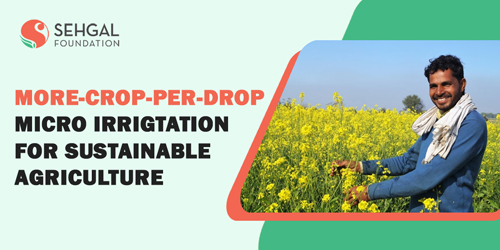Introduction:

In today's rapidly changing agricultural landscape, the need for sustainable and efficient irrigation practices has become increasingly crucial. With water scarcity concerns and a growing global population, traditional irrigation methods are proving to be ineffective and wasteful. However, through innovative techniques like micro-irrigation, farmers worldwide are improving water-use efficiency and crop productivity while minimizing environmental impact. In this blog, we explore the fascinating world of micro-irrigation, its benefits, and its potential to revolutionize agricultural practices.
1. Understanding Micro-Irrigation:
Micro-irrigation is an advanced irrigation technique that involves the precise application of water directly to the plant's root zone. It utilizes low-pressure systems, such as drip irrigation and sprinklers, to deliver water and nutrients in controlled quantities. This precision-based approach eliminates the need for excessive water use and minimizes the potential for evaporation, runoff, and soil erosion.
2. Key Components of Micro-Irrigation:
a. Drip Irrigation:
Drip irrigation is one of the most widely used micro-irrigation techniques. It involves the emission of water through small, evenly spaced emitters or drippers that supply water directly to the plant's root system. This method reduces water loss through evaporation and delivers water directly to where it is needed the most. It allows for uniform water distribution, decreased weed growth, and better nutrient management.
b. Sprinkler Systems:
Sprinkler systems, another facet of micro-irrigation, disperse water through nozzles that create a spray pattern. This technique uses low-pressure and fine sprays, ensuring complete water coverage in a controlled and efficient manner. Sprinklers are particularly suitable for larger agricultural areas where uniform water distribution is essential.
3. Benefits of Micro-Irrigation:
a. Water Conservation:
Micro-irrigation reduces water usage significantly compared to traditional irrigation methods. By applying water directly to the plant's root zone, it minimizes wastage through evaporation, runoff, and deep percolation. The controlled application of water ensures maximum utilization, reducing water stress on crops and preserving this valuable resource for future generations.
b. Enhanced Crop Production:
Micro-irrigation provides an optimal growing environment for crops, promoting healthy root development and increased nutrient absorption. By consistently providing water and nutrients to the plant's roots, micro-irrigation fosters better plant health, leading to increased crop yields, improved quality, and higher profitability for farmers.
c. Weed Control:
Since water is specifically targeted at the plant's root zone, micro-irrigation reduces moisture availability for weed growth. By minimizing weed competition, farmers can allocate resources more efficiently, resulting in healthier crops and reduced labor costs associated with weed management.
d. Environmental Impact:
With traditional irrigation techniques, excess water often carries fertilizers and pesticides into water bodies, causing pollution. Since micro-irrigation delivers water directly to the plant's roots, the risk of chemical runoff is significantly reduced. This environmentally friendly approach helps maintain water quality and prevents the contamination of nearby ecosystems.
4. Implementing Micro-Irrigation:
To successfully implement micro-irrigation systems, farmers should consider various factors, including soil conditions, crop types, weather patterns, and available resources. Adequate system planning, precise equipment selection, and regular maintenance are essential for maximizing the benefits of micro-irrigation.
5. Conclusion:
Micro-irrigation holds immense potential for transforming agricultural practices. By utilizing advanced irrigation techniques like drip irrigation and sprinklers, farmers can optimize water usage, enhance crop productivity, and mitigate environmental concerns. It is imperative for policymakers, agricultural organizations, and farmers to embrace the advantages of micro-irrigation and pave the way for a sustainable and efficient future in agriculture.
Keywords: micro-irrigation, irrigation techniques, drip irrigation, sprinkler systems, water conservation, enhanced crop production, weed control, environmental impact, implementing micro-irrigation, sustainable agriculture.
